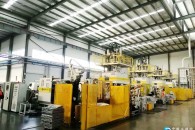(1) Liquid die forging can eliminate the defects such as porosity, shrinkage cavity and porosity in the parts, produce local plastic deformation, and make the parts compact. In addition, crystallization under pressure has obvious effects of refining grains, accelerating solidification speed and homogenizing structure. Therefore, the mechanical properties of liquid forgings are generally higher than ordinary castings, and close to or even reach the level of forgings of the same alloy. At the same time, it does not have the anisotropy that usually exists in forgings.
(2) liquid metal Forming and solidification under pressure make the parts and cavity wall closely fit. The air gap between the dies decreases, so that the thermal conductivity increases and the solidification speed is accelerated, which is conducive to grain refinement. And the hydraulic forging has high Surface finish And dimensional accuracy, which can reach the level of die castings. Therefore, liquid forging has become an important method of near net forming.
(3) During the solidification process of liquid forging, all parts are under the state of compressive stress, which is conducive to the feeding of parts and the prevention of cracks in parts. Therefore, the liquid process is more practical, and the applicable alloy is not limited by the casting quality. It is not only suitable for alloys with good casting performance, but also suitable for alloys with poor casting performance Wrought alloy 。 It can be used not only for non-ferrous alloys such as aluminum, copper, magnesium and zinc, but also for ferrous metals such as iron and steel, as well as nickel and cobalt Superalloy It can even be used for composite materials and cast stones.
(4) Liquid die forging is carried out on a press or squeeze casting machine. It is convenient to realize mechanization and automation, can greatly reduce the labor intensity of people, and improve the production environment of the workshop.
(5) Due to the plastic deformation of the solidified layer, a part of energy is consumed, so the isostatic pressure value of the liquid metal is not fixed, but decreases with the thickening of the solidified layer.
(6) Under the action of pressure, forced feeding occurs in the solid-liquid area of liquid die forging. For thin-walled and complex parts, the application of this process will be limited because the condensation speed of the parts is fast and sometimes the parts solidify without pressure













